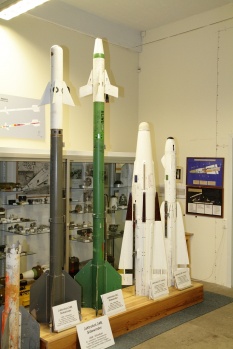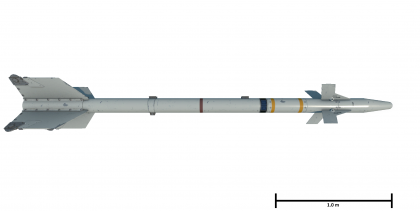Difference between revisions of "AIM-9P Sidewinder"
(→Vehicles equipped with this weapon) |
m (→Pros and cons: Added a Pro) (Tag: Visual edit) |
||
| Line 61: | Line 61: | ||
'''Pros:''' | '''Pros:''' | ||
| + | |||
| + | Amazing 20G Maximum overload | ||
| + | |||
* | * | ||
'''Cons:''' | '''Cons:''' | ||
| + | |||
* | * | ||
| Line 70: | Line 74: | ||
When the [[AIM-9L Sidewinder]] began to be put into production in 1976 replace other Sidewinder variants as the United States' main {{annotation|IR|infrared}} missile,<ref name="WestrumPG1">Westrum 2013, p.196</ref> a need was created for Sidewinders to offer to the United States' allies that did not need or were not allowed access to the newest AIM-9 Sidewinder variants and their associated features such as all-aspect locking.<ref name="ParschAIM9">Parsch 2008</ref> | When the [[AIM-9L Sidewinder]] began to be put into production in 1976 replace other Sidewinder variants as the United States' main {{annotation|IR|infrared}} missile,<ref name="WestrumPG1">Westrum 2013, p.196</ref> a need was created for Sidewinders to offer to the United States' allies that did not need or were not allowed access to the newest AIM-9 Sidewinder variants and their associated features such as all-aspect locking.<ref name="ParschAIM9">Parsch 2008</ref> | ||
| − | The '''AIM-9P''' Sidewinder missile was developed as a family of export missiles. Sponsored by the US Air Force, this variant was based off the [[AIM-9J Sidewinder|AIM-9J]]/N variants, though will be updated multiple times incorporating new features and improvements.<ref name="ParschAIM9"/><ref name="KoppAUSAIM9">Kopp 2014</ref> | + | The '''AIM-9P''' Sidewinder missile was developed as a family of export missiles. Sponsored by the US Air Force, this variant was based off the [[AIM-9J Sidewinder|AIM-9J]]/N variants, though will be updated multiple times incorporating new features and improvements.<ref name="ParschAIM9" /><ref name="KoppAUSAIM9">Kopp 2014</ref> |
[[File:RB24B_RB24J_RB27_RB28.jpg|right|thumb|x350px|none|A row of Swedish missile armaments for aircraft. A [[RB24J]] (Swedish designation for an AIM-9P-3) is seen second from the left.]] | [[File:RB24B_RB24J_RB27_RB28.jpg|right|thumb|x350px|none|A row of Swedish missile armaments for aircraft. A [[RB24J]] (Swedish designation for an AIM-9P-3) is seen second from the left.]] | ||
;Variants of the AIM-9P: | ;Variants of the AIM-9P: | ||
| + | |||
* '''AIM-9P''' - The first version, which is an improved AIM-9J model with greater engagement ranges. It also incorporates solid-state technology for better reliability and maintainability. Deliveries of this missile starts in 1978.<ref name="GlobalSecAIM9">GlobalSecurity.org "AIM-9 Sidewinder"</ref> | * '''AIM-9P''' - The first version, which is an improved AIM-9J model with greater engagement ranges. It also incorporates solid-state technology for better reliability and maintainability. Deliveries of this missile starts in 1978.<ref name="GlobalSecAIM9">GlobalSecurity.org "AIM-9 Sidewinder"</ref> | ||
| − | * '''AIM-9P-1''' - Introduces an active optical target detector with the DSU-15/B AOTD laser proximity fuze, replacing the old infrared influence fuze.<ref name="ParschAIM9"/><ref name="GlobalSecAIM9"/> | + | * '''AIM-9P-1''' - Introduces an active optical target detector with the DSU-15/B AOTD laser proximity fuze, replacing the old infrared influence fuze.<ref name="ParschAIM9" /><ref name="GlobalSecAIM9" /> |
| − | * '''AIM-9P-2''' - Introduces a reduced-smoke rocket motor.<ref name="ParschAIM9"/><ref name="GlobalSecAIM9"/> | + | * '''AIM-9P-2''' - Introduces a reduced-smoke rocket motor.<ref name="ParschAIM9" /><ref name="GlobalSecAIM9" /> |
| − | * '''AIM-9P-3''' - Alongside the reduced-smoke rocket motor like the preceding P-2, the P-3 also includes a new insensitive munitions warhead and improved guidance and control section. Fuzing appears to be a mix of the original infrared fuze or the active optical target detector as the P-1.<ref name="ParschAIM9"/><ref name="GlobalSecAIM9"/> The AIM-9P-3 is also the basis of the Swedish [[RB24J]] missile.<ref name="GoebelAirVectors">Goebel 2021</ref> | + | * '''AIM-9P-3''' - Alongside the reduced-smoke rocket motor like the preceding P-2, the P-3 also includes a new insensitive munitions warhead and improved guidance and control section. Fuzing appears to be a mix of the original infrared fuze or the active optical target detector as the P-1.<ref name="ParschAIM9" /><ref name="GlobalSecAIM9" /> The AIM-9P-3 is also the basis of the Swedish [[RB24J]] missile.<ref name="GoebelAirVectors">Goebel 2021</ref> |
| − | * '''AIM-9P-4''' - Introduces {{annotation|ALASCA|All-Aspect Capability}} features and technology of the AIM-9L variants.<ref name="ParschAIM9"/> However, it is considered less agile to the AIM-9L variant.<ref name="KoppAUSAIM9"/> | + | * '''AIM-9P-4''' - Introduces {{annotation|ALASCA|All-Aspect Capability}} features and technology of the AIM-9L variants.<ref name="ParschAIM9" /> However, it is considered less agile to the AIM-9L variant.<ref name="KoppAUSAIM9" /> |
| − | * '''AIM-9P-5''' - Introduces {{annotation|IRCCM|Infrared Counter Counter-measures}} incorporated in the AIM-9M variant.<ref name="ParschAIM9"/> This model is also the basis of the Swedish RB74, or RB24L, missile.<ref name="GoebelAirVectors"/> | + | * '''AIM-9P-5''' - Introduces {{annotation|IRCCM|Infrared Counter Counter-measures}} incorporated in the AIM-9M variant.<ref name="ParschAIM9" /> This model is also the basis of the Swedish RB74, or RB24L, missile.<ref name="GoebelAirVectors" /> |
| − | More than 21,000 AIM-9P models were built during its production, though many were rebuilt AIM-9B/E/J. Despite being slated for export use, most of the missiles are in US Air Force inventory.<ref name="ParschAIM9"/> | + | More than 21,000 AIM-9P models were built during its production, though many were rebuilt AIM-9B/E/J. Despite being slated for export use, most of the missiles are in US Air Force inventory.<ref name="ParschAIM9" /> |
== Media == | == Media == | ||
| Line 92: | Line 97: | ||
;Related development | ;Related development | ||
| + | |||
* [[AIM-9 Sidewinder (Family)]] | * [[AIM-9 Sidewinder (Family)]] | ||
| Line 105: | Line 111: | ||
;Bibliography | ;Bibliography | ||
| + | |||
* <nowiki>GlobalSecurity.org</nowiki> "AIM-9 Sidewinder." ''<nowiki>GlobalSecurity.org</nowiki>'', [https://www.globalsecurity.org/military/systems/munitions/aim-9.htm Website]. Accessed 02 Apr 2021 ([https://web.archive.org/web/20210402165614/https://www.globalsecurity.org/military/systems/munitions/aim-9.htm Archive]). | * <nowiki>GlobalSecurity.org</nowiki> "AIM-9 Sidewinder." ''<nowiki>GlobalSecurity.org</nowiki>'', [https://www.globalsecurity.org/military/systems/munitions/aim-9.htm Website]. Accessed 02 Apr 2021 ([https://web.archive.org/web/20210402165614/https://www.globalsecurity.org/military/systems/munitions/aim-9.htm Archive]). | ||
* Goebel, Greg. "The Falcon & Sidewinder Air-To-Air Missiles." ''Air Vectors'', 01 Mar. 2021, [http://www.airvectors.net/avusaam_1.html Website]. Accessed 02 Apr 2021 ([https://web.archive.org/web/20210402164339/http://www.airvectors.net/avusaam_1.html Archive]). | * Goebel, Greg. "The Falcon & Sidewinder Air-To-Air Missiles." ''Air Vectors'', 01 Mar. 2021, [http://www.airvectors.net/avusaam_1.html Website]. Accessed 02 Apr 2021 ([https://web.archive.org/web/20210402164339/http://www.airvectors.net/avusaam_1.html Archive]). | ||
Revision as of 19:46, 13 December 2022
| This page is about the American air-to-air missile AIM-9P Sidewinder. For other versions, see AIM-9 Sidewinder (Family). |
Contents
Description
The AIM-9P Sidewinder is an American infrared homing air-to-air missile, it was introduced in Update "New Power".
As an export version of the AIM-9 Sidewinder, the AIM-9P delivers performance akin to that of the AIM-9J that allows for the AIM-9P to be used as a dogfighting missile against low-manoeuvring aircraft.
Vehicles equipped with this weapon
General info
| Missile characteristics | |
|---|---|
| Mass | 76 kg |
| Guidance | IR |
| Aspect | Rear-aspect |
| Lock range (rear-aspect) | 5.5 km |
| Launch range | 18 km |
| Maximum speed | 2.5 M |
| Maximum overload | 20 G |
| Missile guidance time | 40 secs |
| Explosive mass | 7.62 kg TNTeq |
Effective damage
Describe the type of damage produced by this type of missile (high explosive, splash damage, etc)
Comparison with analogues
Give a comparative description of missiles that have firepower equal to this weapon.
Usage in battles
Describe situations when you would utilise this missile in-game (vehicle, pillbox, base, etc)
Pros and cons
Summarise and briefly evaluate the weaponry in terms of its characteristics and combat effectiveness. Mark pros and cons as a list.
Pros:
Amazing 20G Maximum overload
Cons:
History
When the AIM-9L Sidewinder began to be put into production in 1976 replace other Sidewinder variants as the United States' main IR missile,[1] a need was created for Sidewinders to offer to the United States' allies that did not need or were not allowed access to the newest AIM-9 Sidewinder variants and their associated features such as all-aspect locking.[2]
The AIM-9P Sidewinder missile was developed as a family of export missiles. Sponsored by the US Air Force, this variant was based off the AIM-9J/N variants, though will be updated multiple times incorporating new features and improvements.[2][3]

- Variants of the AIM-9P
- AIM-9P - The first version, which is an improved AIM-9J model with greater engagement ranges. It also incorporates solid-state technology for better reliability and maintainability. Deliveries of this missile starts in 1978.[4]
- AIM-9P-1 - Introduces an active optical target detector with the DSU-15/B AOTD laser proximity fuze, replacing the old infrared influence fuze.[2][4]
- AIM-9P-2 - Introduces a reduced-smoke rocket motor.[2][4]
- AIM-9P-3 - Alongside the reduced-smoke rocket motor like the preceding P-2, the P-3 also includes a new insensitive munitions warhead and improved guidance and control section. Fuzing appears to be a mix of the original infrared fuze or the active optical target detector as the P-1.[2][4] The AIM-9P-3 is also the basis of the Swedish RB24J missile.[5]
- AIM-9P-4 - Introduces ALASCA features and technology of the AIM-9L variants.[2] However, it is considered less agile to the AIM-9L variant.[3]
- AIM-9P-5 - Introduces IRCCM incorporated in the AIM-9M variant.[2] This model is also the basis of the Swedish RB74, or RB24L, missile.[5]
More than 21,000 AIM-9P models were built during its production, though many were rebuilt AIM-9B/E/J. Despite being slated for export use, most of the missiles are in US Air Force inventory.[2]
Media
Excellent additions to the article would be video guides, screenshots from the game, and photos.
See also
- Related development
External links
References
- Citations
- Bibliography
- GlobalSecurity.org "AIM-9 Sidewinder." GlobalSecurity.org, Website. Accessed 02 Apr 2021 (Archive).
- Goebel, Greg. "The Falcon & Sidewinder Air-To-Air Missiles." Air Vectors, 01 Mar. 2021, Website. Accessed 02 Apr 2021 (Archive).
- Kopp, Carlo. "The Sidewinder Story: The Evolution of the AIM-9 Missile." Air Power Australia, 27 Jan 2014, Website. Accessed 02 Apr 2021 (Archive).
- Parsch, Andreas. "AIM-9." Directory of U.S. Military Rockets and Missiles, Designation-Systems.Net, 09 July 2008, Website. Accessed 02 Apr 2021 (Archive).
- Westrum, Ron. Sidewinder; Creative Missile Development at China Lake. Naval Institute Press, 30 Sep. 2013.




